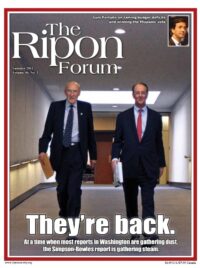
It’s a new trade partnership under negotiation by the United States: potentially larger than NAFTA or a new Doha round, and critical to American prospects for expanded export markets. Yet, it is largely unknown to the American public.
The Trans Pacific Partnership (TPP) is a strange creation. It is an idea embraced by the Bush Administration at its modest launch, which has blossomed under the Obama Administration into a broadening Asia-Pacific engagement including Australia, Brunei, Chile, Malaysia, New Zealand, Peru, Singapore and Vietnam, along with (recently) Canada and Mexico.
Unlike traditional bilateral free trade agreements, such as the recently approved Bush-negotiated pacts with Korea, Columbia and Panama, the TPP structure moves well beyond dismantling conventional border-related barriers to free trade, and aspires to promote deeper economic integration and convergence by reducing more subtle internal anti-competitive factors. The TPP process is now building to a potential year-end conclusion, but so far with a secret negotiation conducted with minimal public input and, on Capitol Hill, without the traditional delegation of fast track negotiating authority by the United States Congress.
Nevertheless, this obscure negotiation — ignored in a blizzard of Presidential campaign roughhousing and bad economic news — represents a huge opportunity and challenge for the U.S. economic leadership in the Asia-Pacific region, and potential access to a robust and dynamic $20.5 trillion dollar market.
The Trans Pacific Partnership has the potential to produce a world class agreement to spawn the world’s largest free trade zone in a Pacific Rim where local bilateral trade agreements have increasingly limited U.S. market access for agricultural products, manufacturers and services. The Peterson Institute projects that the TPP could produce annual income gains of $295 billion globally and $78 billion for the United States — an economic boost substantially larger than a completed Doha round at the WTO. The TPP has the potential to secure export markets for American producers increasingly disadvantaged by local competition, as well as products from the European Union and Australia.
The Trans Pacific Partnership has the potential to produce a world class agreement to spawn the world’s largest free trade zone in a Pacific Rim where local bilateral trade agreements have increasingly limited U.S. market access for agricultural products, manufacturers and services.
For trade policy, the TPP represents an important evolution in the dimensions of free trade agreement negotiations. The negotiation aspires to roll back traditional tariff barriers and quotas, while at the same time promote regulatory and legal coordination in new areas. The negotiations have proceeded for agriculture, financial services, rules of origin, investment, intellectual property, labor and environmental standards, and government procurement, along with less conventional objectives such as competition by state owned enterprises (SOEs), health and safety regulations, and supply chain management. These additional dimensions, coupled with the potential for TPP to continue expanding its membership, give this prospective agreement a special significance in America’s international economic policy. The prospect of TPP extended to Columbia, Korea and possibly Japan also raises the stakes and the complexity of the negotiations.
For the United States, the TPP is an enormous potential breakthrough in trade policy and an indispensible theater for American leadership, at a time when our role in global economic policy is under challenge and the competitiveness of our national economy is at risk. The agreement, by including Mexico and Canada, has the potential to modernize NAFTA in a politically palatable fashion, while promoting an integrated manufacturing supply chain in North America. It offers the prospect of contributing substantial benefits to key sectors of the U.S. economy, including automotive, agriculture, pharmaceuticals and telecommunications, and creating special economic opportunities in key states such as Ohio and California. Strategically, TPP can be an important element in a fundamental rebalancing of U.S. foreign policy, creating a trading network in the Asia Pacific region linked to America, and ratifying a vital American presence throughout. At a time when many policy makers are expressing concern about the rising economic profile and trade practices of China, the Trans Pacific Partnership should provide a healthy counterweight to the Chinese and their own emerging economic networks.
Perhaps most important, the Trans Pacific Partnership would provide a large and needed boost for rules-based trade in the global economy, at a time when the WTO process appears to have lost critical momentum. As a global economy, American commerce can only flourish under a trading regime that asserts high standards and imposes predictable and mutually beneficial disciplines. American firms and workers can thrive in a competitive marketplace grounded in true competitive advantage, without the arbitrary disadvantage of local parochial barriers or protectionism. The United States would be one of the primary beneficiaries of a stronger, more transparent rules-based global trading system that would minimize favoritism and corruption. A successful TPP would create a strong catalyst to accelerate the evolution of a stronger and more disciplined trading regime consistent with these principles. In other words, it would foster a race to the top.
Perhaps most important, the Trans Pacific Partnership would provide a large and needed boost for rules-based trade in the global economy, at a time when the WTO process appears to have lost critical momentum.
The prospects for the successful completion of a world class Trans Pacific Partnership agreement are good, although reportedly some of the most difficult issues are yet to be crystallized. Unlike the Doha round, the TPP has so far been cast as mutually beneficial to a broad range of trading partners, with substantial benefits offered to both developed and developing nations in the region. Notwithstanding the relative obscurity of TPP negotiations and the lack of public access to texts, the agreement has already stimulated hostility from anti-globalization networks and has been treated with skepticism by parts of organized labor. Without formalized trade promotion authority, the negotiations have given members of Congress comparatively little opportunity for input in the process, although conceptually the TPP has attracted bipartisan support on Capitol Hill.
Ultimately, the Trans Pacific Partnership may rise or fall on the ability of the next Presidential Administration to navigate it quickly through a deeply divided but generally pro-trade Congress in the aftermath of a deep recession and bitter election. Its benefits to the American economy will reflect the ability of the United States Trade Representative to persuade our trading partners to be ambitious in promoting free trade.
The Honorable Phil English represented the 3rd District of Pennsylvania in the U.S. House of Representatives from 1995 to 2009. He is currently a senior government relations advisor at Arent Fox, and serves as co-chair of the firm’s government relations practice.




